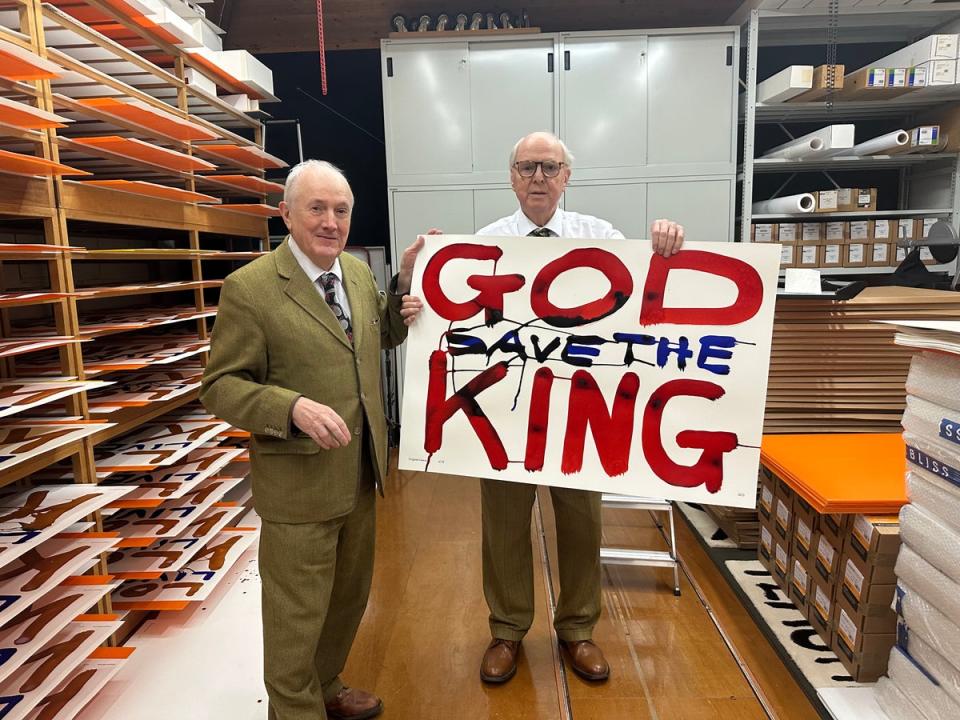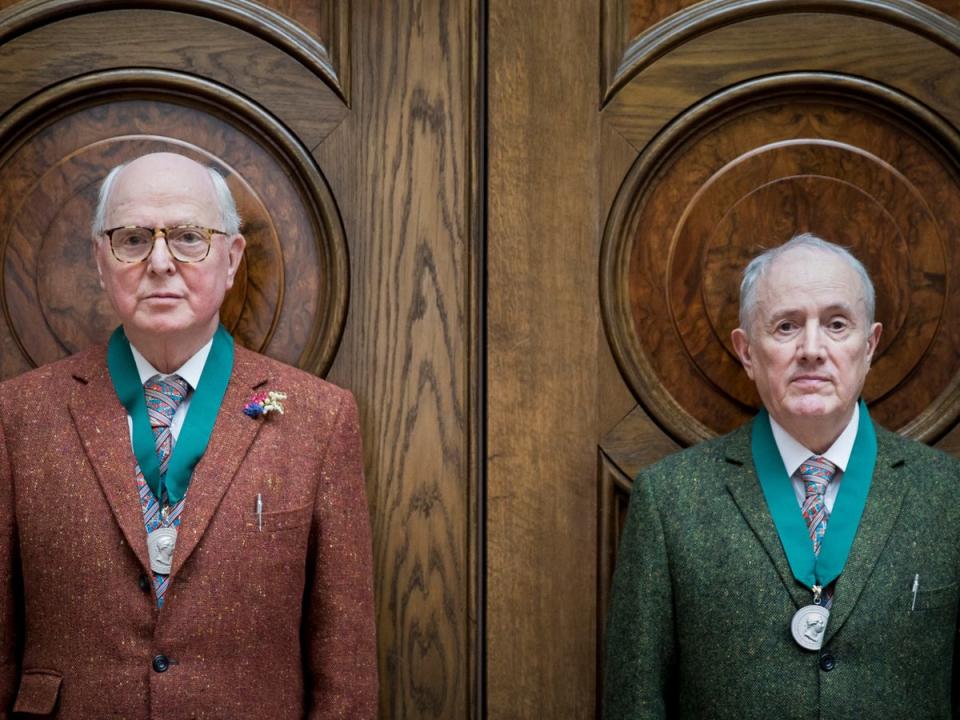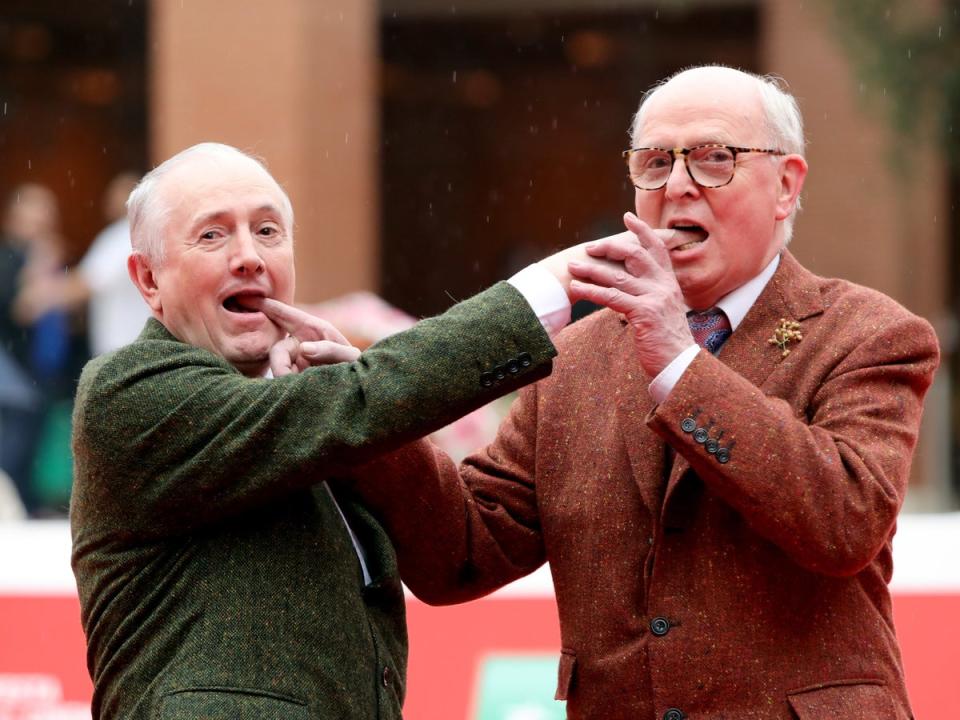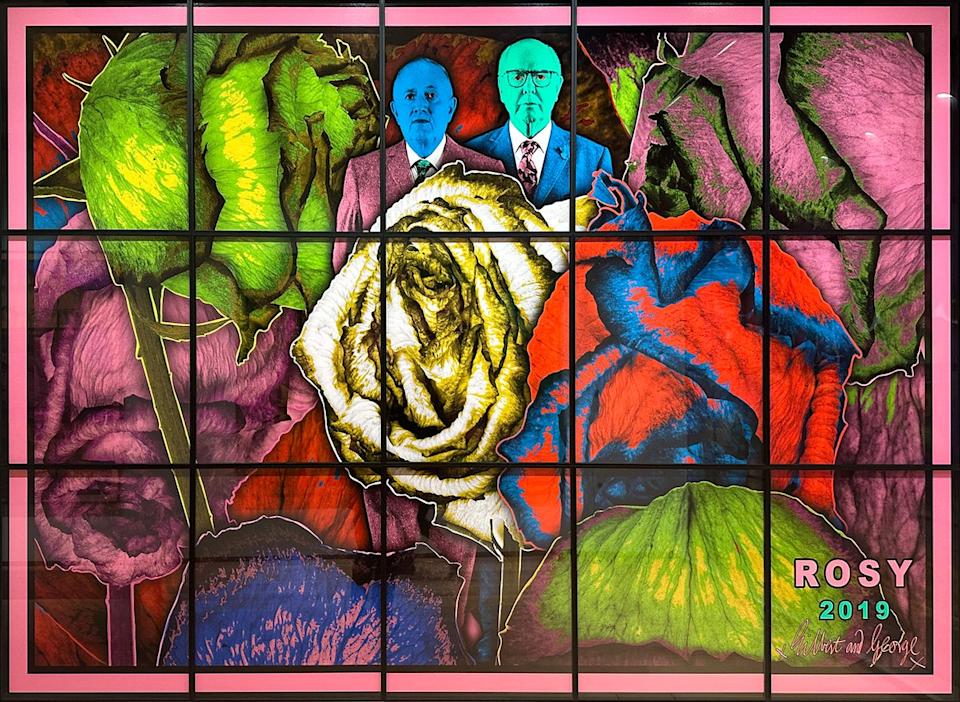‘Sexual attraction is the start of all art’: Gilbert and George on over half a century of life, love and art together

A Rishi Sunak coffee mug showing the PM’s toothy smile sits on the table between the artists Gilbert and George.
“He is so handsome,” says Gilbert.
“Dashing,” echoes George.
As we sit in their 18th-century townhouse in London’s East End, the bad boys of the art world and longest-lasting art duo (55 years) – as famous for being living sculptures as for making their extreme art (their Naked S*** pictures depicted human faeces) – are purring over Prime Minister Sunak.
“He is such a clear speaker on television. We definitely like him,” says George, a lifelong Tory voter (Gilbert has never voted). “Conservative means radical,” continues George, neatly buttoned in a green tweed suit almost matching Gilbert’s, just a shade browner. “Or, at least, it does in the art world, because artists are almost all lefties.” Yet Gilbert and George are no archetypal Tories.
Their picture titles are enough to stop anyone, Tory or Marxist, in their tracks: Date Stone F*** and Eaten Mess are two newly displayed works for their exhibitions, Paradisical Pictures and Corpsing Pictures. Gilbert and George like to grab the viewer by the balls – they depict only men (usually themselves) to create prophetic, socially-charged, bold images on the themes of sex, death, fear, money, race and religion.
Shocking in an altogether different way is they have now made a set of patriotic ink-wash prints to celebrate the accession of King Charles III. The eight striking graffiti posters bear messages like “Long Live the King” to cheer on the new reign in eight editions of 50. “We like King Charles very much. He is an optimistic person who loves to do things – so do we,” says George. One ink wash is already destined for the Royal Collection, reserved by a family member.
Their monarchical mania extends also to new cast-iron gates at the entrance to the Gilbert and George Foundation museum in Spitalfields, east London. An EIIR insignia was, after the Queen’s sudden death, swapped for a CIIIR. Their permanent new gallery, only showing Gilbert and George pictures, has been privately funded with £11m from the artists themselves, and opens this week to the public. “The King is great for Britain. Better than having a politician who then goes to prison or is arrested,” says George.

The artists love their new Gilbert and George space. “We believe that art is the ultimate democratising power. It changes people. We like expressing ourselves and now our works will be on display forever. It is about being alive. That is what it is,” they intone, almost simultaneously. More than 400 pictures owned by them will be rotated for different exhibitions. “We open to the world. We never look back; whatever is finished is finished. We only look at what is in front of us every day,” says George.
It is 55 years since the couple met in London at St Martin’s School of Art school and, apart from when Gilbert’s mother died and he went to Italy to bury her, they have barely spent a night apart. George, 81, from Devon, and Gilbert, 79, from the Dolomites, dress every day like semi-identical twins, sharing the same Spitalfield house as well as the same ideas, themes and even phrases for their art.
Yet their bond is complex. Key word to avoid: collaboration.
“We NEVER collaborate,” says Gilbert.
“It is a dirty word from the last war,” hisses George, only half joking.
Nevertheless, they are generous about each other’s contribution.
“We would never have done what we did alone. Ever,” says Gilbert, before adding, “Don’t you think, George?”
“No question,” he agrees. Interviewing them is not unlike watching ping-pong as they bat answers back and forth, fast and often with a devilish top spin. “Don’t think we are not weird,” adds George.
When it came to their purpose, they “didn’t want to do what every other student did at art school which was to make a living. We walked around London and wanted to make art for all. And we found a new way of making it,” says Gilbert… or is it George? Not a cigarette paper can be slipped between them on anything.
“None of what we do is based on any preconceived idea. It is just what we do,” says George.
“We know things which other artists certainly don’t. Our life became our art. It became an artwork. It is also our life,” Gilbert continues.

Their talk combines the certainty of scholars, the ambivalence of comedians and the obsessional dedication of artists. They sway from wisecracks (jokes not suitable for a family newspaper) to homespun philosophy (“We never waste time being negative about anything”). George laughs when I look perplexed: “As I just said, we are weird, but you know that,” he reminds me.
And it is hard to find an odder 21st-century couple. No mobile phones. No email. A landline that is listed and yet no one ever calls. No kitchen in their home. They only eat out. Every day they go to the same Turkish restaurant, taking two buses and always have the same lamb dish. They only wear formal suits and ties, all day and every day, cut by a Tibetan tailor nearby. They are gregarious but have also become hermits of the art world. Thirty years ago, they decided never to go to an art show, cinema, ballet or opera. They wanted to concentrate only on their own art. Their one concession to contemporary life is a TV. The afternoon I saw them they had watched a documentary on Stalin. “As you are asking about sin, he fulfils that brief,” says Gilbert.
In 2008 Gilbert and George got married, which they see less as a gesture of romance, more as a legal nicety. “It was down to our Foundation. We were told what to do for the most practical reasons.” But inheritance and legacy aside they remain devoted to each other. “Love is the second greatest driving force in the world,” says George with a glint.
“So that leaves sex…” he continues, “sexual attraction – that is the start of all art. It is all mixed up, but you know what I mean. It is hard,” he says, leaving the double entendre hanging in the air.
So, as we are getting onto more personal territory, I ask Gilbert what he loves about George.
“Too much,” George interjects. “This is intrusive.”
But Gilbert answers anyway. “George is the most clever and most funny man in the world.”
George’s turn. “Gilbert is the most important person I have ever met,” he says, reluctantly but heartfelt.
Privacy is an unlikely issue for this couple who, for their art, have posed naked, ditched all modesty and decorum, and never shied away from sex, death, drugs, even pubic lice as subjects upon which they and their art merge absolutely. “Just remember we are private as well as very public. I just advise people who want to know more than what we tell interviewers that they should look at our pictures. Everything is revealed there.”
“One part is art, and the other is the art,” adds Gilbert. “The art we are making is completely open, but Gilbert and George are separate.”
“Look at the pictures,” says George. “Sex, race, religion, death, hope, life, fear. It is all there.”
“What is most striking and completely unbelievable is we've lived 55 years together,” Gilbert says. “It is unbelievable. You could not make that up.” George nods.

They are funny and original, mysterious and magical, controlling and controversial, and over five decades they changed the language of art. They are also as recognisable in person as their artworks (“And we did it without using buckets of paint!”) Their art is a photographic process. And they have always avoided category or definition. “We walked through the streets of London in the 1960s and realised we could be the subject of our art,” George says.
“We are outsiders. We have never been part of anything,” says Gilbert, and George agrees: “We were outsiders because we came from poor families. It is also very privileged to come from our lower-class background. All the others at art school would take a grant and then disappear.”
Well, Gilbert and George certainly did not disappear, making art, money and waves since 1967 when they were living sculptures on the street. “We became famous overnight and that remains. We were very lucky,” said Gilbert. A key moment was in the 1970s, in Düsseldorf, when they made a paper sculpture and asked the then outrageous price of £1,000 for it – and, to their astonishment, received it. It started a roll of international sales and so the G and G empire began.
Their new pictures, some of which date back several years but have never been exhibited in the UK, show images of bones, leaves and jungle forest. And, as always, Gilbert and George in suits. So how do they decide what to depict alongside themselves? They explain an almost mystical connection and process.
“Things like the bones tell us things, like the bones we saw. They speak to us. We don’t specifically look for things of interest and even though we have seen bones for 50 years it was only when they started to speak to us that we started to think of life and death,” says George.
We are outsiders. We have never been part of anything
The two Gs see their career as a “Pilgrim’s Progress” and they hint at a spiritual dimension, even though they don’t follow any faith, and especially not the Christian God. Bravely or perhaps insanely some churches have asked them to make a picture: “But we can’t think of putting our work in churches – that would be collaborating with the enemy! We are outsiders. We have never been part of anything,” says Gilbert.
And so to the paradisical pictures. “We show an artificial jungle which we created to walk through in order to pretend to be in paradise. It is about the here and the now – every living moment is paradise. We created them for people who believe in the afterlife and also for those who don’t believe in the afterlife. The pictures address both communities.” A sort of cake and eatism!
The pair show the fervour and certainty of gurus but with no faith or belief except in art. They are missionaries, crusaders even, but their credo is their very irreligious subjects. “We walk the streets of London, Manhattan, Sydney, Melbourne, plus cities in China and Russia. We want to spread the word of art as well as our own art,” says Gilbert.
Any limit on their own mortality as they approach 80? “Far too early to contemplate,” mocks George, adding, “Life is paradise because death is not paradise.” Any afterlife is apparently ruled out: “Death means finito,” says Gilbert. But according to George, art provides the key to eternity and adds: “We want to live forever.” Curiouser and curiouser, as Alice observed in her own Wonderland.
They believe almost religiously in the supreme power of art. “Look at Van Gogh, in whose paintings you can see tree trunks gnarled like a grandfather’s hands. That is living culture. Van Gogh still talks and alters people’s views, literally: speaking from the grave, the living future. Art does not die. Look at Charles Dickens who has never been out of print. His books speak from the grave.”

So are they embarrassed that they depict only men? “Not at all. We are doing ourselves really in our art, and what we choose to see. We are doing us. We don’t want to do women or motorcars, refrigerators or planes. We are not reflecting life; we are showing ours. We are forming our tomorrows. We are trying to make tomorrow different,” says George.
There is a price to be paid for looking and being different. At different times they have been beaten up, once after being turned away from a pub.
“I was attacked and then in hospital for two days,” Gilbert explains. “We had been to see a fantastic horror film. Afterwards we wanted to go for a drink, but the pub nearby would not let us in. We said you are not allowed to not let us in as it is what it says it is: a public house.
“They followed us and came back for us. They waited outside before they knocked us out.”
“After we had been attacked, I was potentially concussed, and someone wanted to ask me what had happened,” George continues, picking up the story. “A little confused – or maybe a lot confused – I repeated the storyline of the horror film. It was along the lines of … We come down from the battlements of the castle.” George and Gilbert roar with laughter at the non sequitur. “The attackers actually had jumped up and ran away. But we were eventually fine. Things happen!”
So, the last time they were in tears? “That is easy; when the Queen died. The extraordinary moment when we saw her on television, coming down from Scotland. Beyond sad…”
Gilbert and George are impossible to pin down on identity politics. They know which controversies to poke and which to avoid. They are also cool about the art market.
“Ninety-nine per cent who look at our art and admire it never think of pictures being for sale. Young people at shows never ask the price: they might think what the hell is this about, but not what price it is. Most young people compare our art to space invaders. We prefer that to those who have been dragged into cathedrals by middle-class parents who then compare our work to stained glass. We are on the side of the young. We want art for everyone.”
The Gilbert & George Centre opens on 1 April. Corpsing Pictures is at White Cube Mason's Yard from 29 March until 20 May

